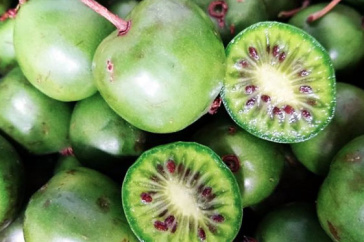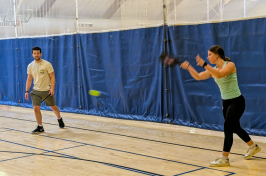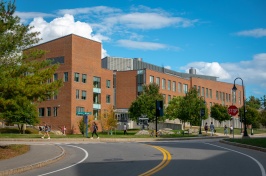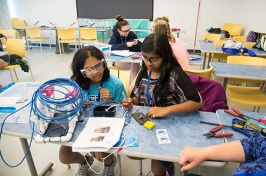The University of New Hampshire is a flagship research university that inspires innovation and transforms lives in our state, nation and world. More than 16,000 students from all 50 states and 71 countries engage with an award-winning faculty in top ranked programs in business, engineering, law, health and human services, liberal arts and the sciences across more than 200 programs of study. UNH’s research portfolio includes partnerships with NASA, NOAA, NSF and NIH, receiving more than $100 million in competitive external funding every year to further explore and define the frontiers of land, sea and space.
UNH Agricultural Research Boosts New England’s Thanksgiving Bounty

Kiwiberries are a good selection for beer because they offer a flavor that is delicate and blends well with the sour style brew UNH is making, a Berliner-Weisse. Credit: UNH
DURHAM, N.H.—As New Englanders prepare to gather with family and friends for Thanksgiving their table may be filled with locally and regionally grown foods thanks to agricultural research conducted by the NH Agricultural Experiment Station at the University of New Hampshire.
No Thanksgiving would be complete without winter squash and pumpkins. For five decades, support from the NH Agricultural Experiment Station has allowed J. Brent Loy, emeritus professor of plant genetics, to undertake the longest continuous cucurbit breeding program in North America. As a result, New Englanders now enjoy some of the tastiest squash and pumpkins on the market today. Loy’s work has resulted in more than 70 new varieties of squash, pumpkins, gourds, and melons sold in seed catalogs throughout the world, including several released this year.
Historians believe that the first New England Thanksgiving included an abundance of seafood, given the region’s proximity to the ocean. However, 80 percent of the seafood eaten in the United States now is imported. To support sustainable agriculture in the Northeast, the experiment station opened an aquaponic greenhouse facility that aims to provide a model for integrating land-based aquaculture systems with hydroponic plant production. Scientists are raising tilapia, brown trout and rainbow trout, which provide nutrients for growing lettuce.
Someday, kiwiberry wine and beer might become a staple for New Englanders because of UNH’s efforts to promote kiwiberries as a new, high-value crop in northern New Hampshire. Plant breeder Iago Hale has established the nation’s first ever kiwiberry breeding research program at the Woodman Horticultural Research Farm. He is characterizing and evaluating the North American collection of kiwiberries, nearly 200 accessions, to identify promising varieties for the region and parent plants for new variety development.
Love cranberry sauce? If you’d like to give it some local zing, look no further than locally grown baby ginger, which is has become increasing popular in the region. Scientists have found that early-season heating and delaying the harvest date increases yields of baby ginger.
Experiment station scientists have quadrupled the length of the Granite State’s strawberry growing season as part of a multi-year research project. New Hampshire’s strawberry season traditionally lasts only four to six weeks. However, researchers working on the multi-state TunnelBerries project were picking day-neutral strawberries in Durham up until last week. This year, researchers harvested strawberries grown in low tunnels for 18 consecutive weeks from mid-July through mid-November.
For those in the Northeast who enjoy southern favorite oyster dressing, scientists are not only helping local oyster farmers understand the ecological impact of oyster farming on Great Bay, but they are helping make sure the oysters from Great Bay are safe to eat. Researchers conducted the first study of oyster farming-nitrogen dynamics in New Hampshire, providing the first solid research on the state’s oyster farming industry and the role oyster farms play with nitrogen removal. In addition, researchers have developed a predictive modeling tool capable of estimating the likelihood of Vibrio parahaemolyticus presence in coastal New Hampshire oysters, and have identified a new strain of the bacterial pathogen.
Consumers of Hood or Stonyfield vanilla ice cream (and those getting a head start on their egg nog) will be enjoying products made from some of the finest milk in the region. Hood sources some of its milk from the Fairchild Dairy Teaching and Research Center, and Stonyfield sources some of its organic milk from the Organic Dairy Research Farm. Both farms have been widely recognized as producing some of the highest quality milk in the nation.
Founded in 1887, the NH Agricultural Experiment Station at the UNH College of Life Sciences and Agriculture is UNH’s original research center and an elemental component of New Hampshire's land-grant university heritage and mission.
PHOTOS AVAILABLE FOR DOWNLOAD
https://colsa.unh.edu/nhaes/sites/default/files/media/images/kiwiberrybeer5.jpg
Kiwiberries are a good selection for beer because they offer a flavor that is delicate and blends well with the sour style brew UNH is making, a Berliner-Weisse. Credit: UNH
https://colsa.unh.edu/nhaes/sites/default/files/media/images/unhhydroponiclettuce.jpg
Researchers recently grew Boston butter head lettuce in 35 days from seed to harvest and hit the magical 150g head weight using only nutrients from the fish. Credit: UNH
https://colsa.unh.edu/nhaes/sites/default/files/media/images/unhaquaponics_1.jpg
Fish provide the nutrients for hydroponic crops. UNH is using tilapia, brown trout, and rainbow trout. Credit: Todd Guerdat/UNH
https://colsa.unh.edu/nhaes/sites/default/files/media/images/unhginger4.jpg
There is growing regional interest in growing baby ginger. It can be used for cooking and can be candied or pickle. It also keeps well in the freezer for culinary use year-round. Credit: Becky Sideman/UNH.
-
Media Contact
Lori Tyler Gula, PhD | NH Agricultural Experiment Station | lori.gula@unh.edu | 603-862-1452
Latest News
-
October 8, 2025
-
October 2, 2025
-
September 24, 2025
-
September 15, 2025
-
August 21, 2025















































